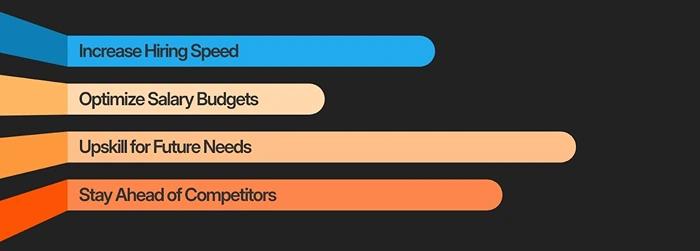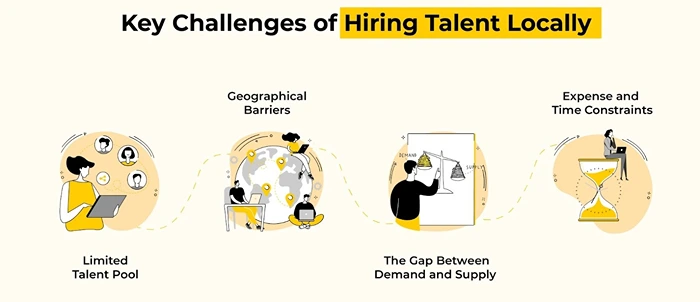Why Labor Market Intelligence Matters More Than Ever? In today’s business, having a deep understanding of the external labor market is no longer optional—it’s essential. Companies that rely only on internal HR data miss the bigger picture. True workforce planning requires looking outward, understanding real-time job market shifts, and acting faster than competitors.
That’s where labor market intelligence comes in. It’s about tapping into external labor market data—job postings, salary trends, location shifts, emerging skills—and using those insights to make better, faster decisions. From predicting where to hire next to staying ahead of talent shortages, labor market analytics are now a competitive weapon.
According to LinkedIn’s Global Talent Trends 2024 report, 74% of HR leaders say external labor market data has become “critical” to their talent strategies. Organizations that integrate labor market intelligence into workforce planning are more agile, make smarter hiring bets, and optimize resources better than those flying blind.
In this article, we’ll explore how enterprises can use labor market intelligence to gain a competitive advantage, with examples across location insights, job demand trends, and salary benchmarks. We’ll also show how platforms like JobsPikr are making it easier than ever to turn raw data into smart talent strategies.
What is Labor Market Intelligence and Why It’s Crucial for Enterprises
Labor market intelligence is the practice of gathering real-time insights from the external job market. It covers trends like hiring patterns, salary benchmarks, skill demand shifts, and workforce movements across regions. Simply put, it helps companies see beyond their internal HR data and understand how the broader talent market is evolving.
Today, relying only on internal data is risky. While knowing your turnover rates or internal skills is important, it does not tell you how competitors are hiring, what salaries are rising, or where new talent hubs are emerging. External labor market analytics fill that gap, offering a much wider and current view.
For example, without labor market intelligence, a company hiring engineers might miss a sudden rise in demand (and salaries) for AI talent in nearby cities. With the right insights, they can adjust hiring plans, budget more accurately, and avoid costly mistakes.
A Deloitte study found that 68% of leading enterprises now use external labor market data to guide workforce planning. This shows that labor market intelligence is no longer optional—it’s a critical tool for staying competitive.
Platforms like JobsPikr help companies tap into these insights easily, providing real-time access to hiring trends, skill shifts, and regional opportunities.
Key Pillars of Labor Market Intelligence: Location, Demand Trends, and Salary Benchmarks
Labor market intelligence becomes truly powerful when you break it down into three core pillars: location insights, job demand trends, and salary benchmarks. These pillars work together to help enterprises make smarter, faster workforce decisions.
Location Insights
Understanding where talent is located is essential. Labor market analytics show which cities or regions are emerging as new talent hubs. For instance, a company expanding its tech team might find that while San Francisco remains expensive, cities like Austin, Berlin, or Bengaluru offer rich pools of qualified candidates at more affordable salary levels.
Location insights also help enterprises plan office expansions, remote hiring strategies, and workforce relocation programs based on real-time talent availability.
Job Demand Trends
Tracking how job demand shifts over time provides a competitive edge. If cybersecurity roles are suddenly spiking in demand across industries, companies that catch this early can move faster to secure talent before salary wars start.
Labor market intelligence platforms like JobsPikr provide daily or weekly snapshots of which roles, industries, and skills are heating up—giving workforce planners time to adapt before the market tightens.
Salary Benchmarks
Setting the right salary for a role is critical for attracting and retaining talent. Labor market data helps companies see what competitors are offering for similar positions in different regions.
Instead of relying on outdated salary surveys, enterprises can now use real-time salary benchmarks to create competitive compensation packages aligned with market realities.

How Labor Market Analytics Drive Smarter Workforce Planning
Workforce planning today demands more than just looking at headcount gaps or budget limits. It requires understanding what is happening in the external labor market—and reacting faster than competitors. This is where labor market intelligence becomes a game-changer.
Faster, More Strategic Hiring
When companies know which roles are in high demand or which regions offer untapped talent pools, they can move quickly. Labor market analytics help prioritize hiring efforts, allocate resources better, and reduce time-to-fill by focusing on areas with strong candidate availability.
For example, if data shows a surge in demand for cloud engineers in North America, a company can immediately target lesser-saturated markets like Toronto or Denver instead of fighting expensive battles in Silicon Valley.
Smarter Cost Control
Labor market intelligence also supports smarter budgeting. By tracking real-time salary benchmarks, enterprises avoid overpaying for roles or losing talent due to outdated compensation structures. Companies can adjust salary bands proactively, keeping both costs and employee satisfaction in check.
Future-Proofing Skill Needs
Job demand trends highlight which skills are emerging, peaking, or declining. Workforce planners can use these signals to design better upskilling programs, prepare for future needs, and avoid skill shortages that slow down growth.
For instance, a rise in AI and machine learning job postings signals the need to start reskilling internal tech teams before external hiring becomes too competitive.
Staying Ahead of Competitors
Lastly, labor market analytics reveal where competitors are expanding, what roles they are hiring for, and which skills they are prioritizing. This intelligence allows enterprises to preemptively adjust their workforce strategies and stay one step ahead.

Real-World Success Stories: Enterprises Winning with Labor Market Intelligence
Seeing how companies put labor market intelligence into action brings the power of this data to life. Here are a few real-world examples where labor market analytics made a real difference.
Expanding into New Talent Markets
A fast-growing fintech company in Europe planned to scale its data science team but found hiring in London both slow and expensive. By using labor market analytics, they discovered that Warsaw and Bucharest were emerging as strong hubs for data science talent, with salaries nearly 30% lower than in London.
Within six months, they successfully built a satellite team in Poland—saving costs and reducing hiring time by half.
Optimizing Remote Hiring Strategies
A U.S.-based technology firm wanted to embrace remote-first hiring but needed data to avoid high-attrition markets. Using external labor market intelligence, they identified stable talent pools in mid-sized cities like Boise and Chattanooga.
Instead of defaulting to major tech hubs, they focused their remote hiring on these cities, achieving 20% better retention rates compared to their previous hiring strategy.
Salary Benchmarking for Competitive Offers
A healthcare organization was struggling to attract cybersecurity specialists. Internal salary bands were based on outdated benchmarks. By accessing real-time salary data through a labor market platform like JobsPikr, they adjusted offers to match market expectations.
Within three months, they saw a 40% improvement in offer acceptance rates, filling critical roles faster.
Predicting Skill Shortages Early
An energy company used job demand trends to spot the rising need for ESG (Environmental, Social, and Governance) specialists long before their competitors reacted. They launched a focused internal upskilling program and secured top talent early—giving them a first-mover advantage in ESG compliance and reporting.

Making Labor Market Intelligence a Core Part of Talent Strategy
The days when internal HR data alone could drive workforce decisions are over. In 2025 and beyond, enterprises that truly want to compete must look outward—constantly monitoring the external labor market to align hiring, compensation, and skill development with real-time demand.
Labor market intelligence provides that critical external view. It helps companies hire smarter, expand into the right regions, stay cost-competitive, and future-proof their workforce against sudden market changes. Whether it’s using location insights to find untapped talent hubs, spotting emerging job trends early, or benchmarking salaries against current standards, labor market analytics are shaping modern enterprise strategies.
Platforms like JobsPikr make it easy to turn complex labor market data into actionable insights. With access to global hiring patterns, real-time salary benchmarks, and emerging skills intelligence, enterprises can make faster, more confident workforce decisions—before competitors even react.
In a world where talent moves fast, the organizations that understand the market best will win.
Are you ready to make labor market intelligence your competitive advantage?
Sign up with JobsPikr today and unlock the power of smart workforce planning.



